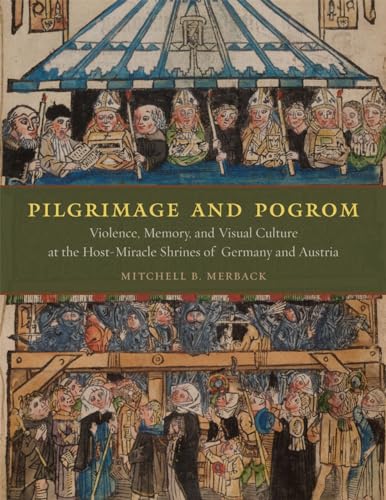Items related to Pilgrimage and Pogrom: Violence, Memory, and Visual...
Pilgrimage and Pogrom: Violence, Memory, and Visual Culture at the Host-Miracle Shrines of Germany and Austria - Hardcover

Synopsis
In the late Middle Ages, Europe saw the rise of one of its most virulent myths: that Jews abused the eucharistic bread as a form of anti-Christian blasphemy, causing it to bleed miraculously. The allegation fostered tensions between Christians and Jews that would explode into violence across Germany and Austria. And pilgrimage shrines were built on the sites where supposed desecrations had led to miracles or to anti-Semitic persecutions. Exploring the legends, cult forms, imagery, and architecture of these host-miracle shrines, Pilgrimage and Pogrom reveals how they not only reflected but also actively shaped Christian anti-Judaism in the two centuries before the Reformation. Mitchell B. Merback studies surviving relics and eucharistic cult statues, painted miracle cycles and altarpieces, propaganda broadsheets, and more in an effort to explore how accusation and legend were transformed into propaganda and memory. Merback shows how persecution and violence became interdependent with normative aspects of Christian piety, from pilgrimage to prayers for the dead, infusing them with the ideals of crusade. Valiantly reconstructing the cult environments created for these sacred places, Pilgrimage and Pogrom is an illuminating look at Christian-Jewish relations in premodern Europe.
"synopsis" may belong to another edition of this title.
About the Author
Mitchell B. Merback is associate professor of the history of art at Johns Hopkins University. He is the author of The Thief, the Cross and the Wheel: Pain and the Spectacle of Punishment in Medieval and Renaissance Europe and editor of Beyond the Yellow Badge: Anti-Judaism and Antisemitism in Medieval and Early Modern Visual Culture.
Review
"A profound, captivating, eloquently written study of the material culture of the most disturbing manifestation of late medieval pilgrimage piety." (Sehepunkte)
“This is a big book on a worthy and truly interdisciplinary topic. Strong, current, and deeply learned, Pilgrimage and Pogrom combines historical investigations of visual cultures used in the service of religion and power, together with associated group practices, pitting Christians against Jews. Mitchell B. Merback’s writing shows mastery as well as confidence, and his research is vast and deep. What emerges will have lasting usefulness for historians of medieval piety, history of Christianity, German history, and art history.”
(Larry Silver, University of Pennsylvania)
“Focusing on pilgrimage sites created around tales of Jewish desecrations of the consecrated communion wafer, Mitchell B. Merback’s Pilgrimage and Pogrom is a compelling study of the role of visual culture and architecture of pilgrimage sites in memory building. His descriptions of the sites bring to life the experience pilgrims may have had. But the most important aspect of the book is Merback’s argument that the legends of Jewish host desecrations emerged in these particular places only after the actual historical drama of Jewish persecution ended. Merback challenges earlier assumptions that stories of Jewish host desecrations led to anti-Jewish violence. Instead, he argues that the tales of desecrations were created later, retroactively justifying violence that had already occurred. Coupled together, the stories and these new physical shrines became redemptive for the community that had participated in anti-Jewish violence. Beyond personal piety, pilgrimage sites with their visual and architectural elements were also of political and cultural significance. Pilgrimage and Pogrom is an important study that brings together questions explored by cultural history, art history, and memory.”
(Magda Teter, Wesleyan University)
"About this title" may belong to another edition of this title.
- PublisherUniversity of Chicago Press
- Publication date2013
- ISBN 10 0226520196
- ISBN 13 9780226520193
- BindingHardcover
- LanguageEnglish
- Edition number1
- Number of pages416
Buy New
View this item
Shipping:
US$ 32.22
From United Kingdom to U.S.A.
Search results for Pilgrimage and Pogrom: Violence, Memory, and Visual...
Pilgrimage and Pogrom: Violence, Memory, and Visual Culture at the Host-Miracle Shrines of Germany and Austria
Seller: Mispah books, Redhill, SURRE, United Kingdom
Hardcover. Condition: New. New. book. Seller Inventory # ERICA82902265201966
Quantity: 1 available
